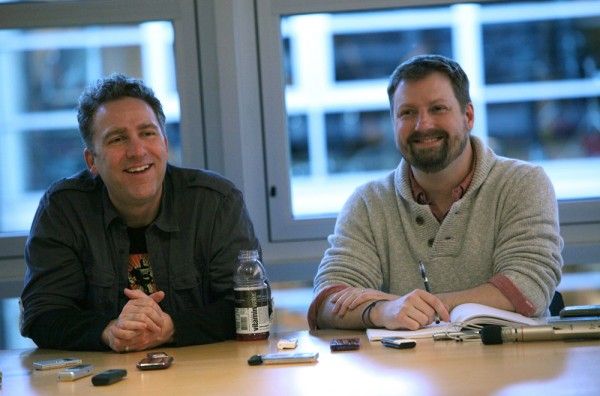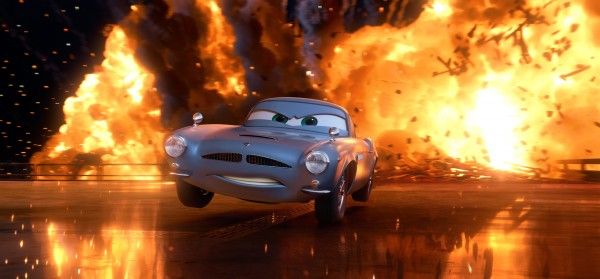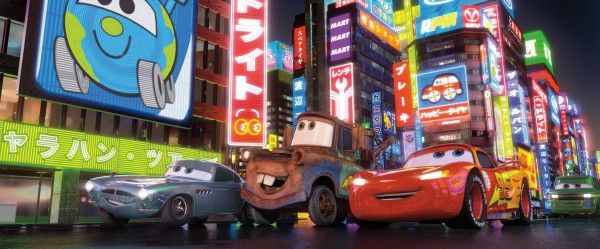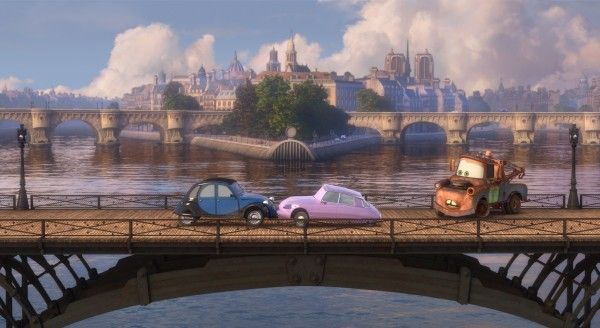As part of our continuing coverage in anticipation of the release of Cars 2 on June 24th, we have our interview with the supervising animators on the film Shawn Krause and Dave Mullins. The two have been with Pixar for a number of years, and served as the directing animators on Up. The powerhouse that is Pixar has been churning out incredible films year after year, and each subsequent entry in the Pixar library is visually more impressive than the last. In our interview, Krause and Mullins gave an inside look into the animation department at Pixar. They talked about what their job as supervising animator entails, the challenges they faced in the making of Cars 2, what their research for the film was like and much more. Hit the jump to check it out.First off, if you’ve missed our previous Cars 2 interviews here’s your chance to catch up:
We’ll be running a new article each week until the release of Cars 2 on June 24th. During our visit to Pixar, it was obvious that everything runs like well-oiled machine. Each department is absolutely vital to the film as a whole, and one of the most crucial departments, as you can imagine, is animation. For Cars 2, Krause and Mullins acted as heads of the animation department and were involved at the very beginning of the film.
In case you don’t get the chance to read the full interview, here are a few highlights:
- As supervising animators, they work inter-departmentally and are the first people in animation to come aboard. They choose the animation team and work with other departments to coordinate. During production, they act as a sounding board for the animators working on the film.
- One of the biggest challenges was having to make animation changes when the story changed, and having to scrap or re-do work that was already done.
- For research they went to a raceway and drove cars through a slalom course. They also rode along with a professional driver in a Formula car on a racecourse and went to Laguna Seca to observe a Le Mans race.
- One of the more interesting aspects regarding the future of animation is the integration of gaming engines and how gaming machines are influencing animation.
- The voice-cast influences how they animate characters. There was a group of voice actors in London that did work on minor characters and their work fed into their animation and excitement.
Collider: Could you talk about what your job entails as a supervising animator here at Pixar?
Krause: We work inter-departmentally, and so we cast our show, we cast the people who are gonna be on our animation team, we cast those shots to those people, and we work with effects and layout and all the other departments to kind of make sure that the machine’s running well across the board. And then we also work top to bottom between—we answer to the producer and the director and then we look down the ranks of the animation department and work with everybody.
Mullins: And the other responsibility we have on the film is, we’re the first two people on the show in the animation department. We’re responsible for building the show, getting it set up, getting it ready, working with characters to get all the characters up and running, putting together all the model sheets, putting together all the reference, getting everything together and then we build our team slowly up. On a show like Cars, a lot of the visual language has been developed for us, or at least the sandbox that we’re gonna play in, but we still have new characters like Zundapp with the monocle, then Finn McMissile with his weapons, and Holly is a new character. And so we’re really responsible for helping develop those characters before we actually start animation production and getting everybody ready to start animation production. During animation production we’re basically a sounding board for the animators when they’re showing shots that they wanna show, if they’re having issues with their shots or they wanna discuss the performance in the shots, we’re always available for them daily in the mornings and afternoons just to walk through and discuss shots with them, and just get the animators together and discuss their shots basically.
So you guys are here from the beginning, what was the most difficult aspect you came across when working on Cars 2?
Mullins: Well I mean there’s a lot of challenges. We had some new characters that we did, but we’re kinda used to that. I think the [hardest part] is as you’re finding the story. And if anything ever needs to change while you’re in production—and it happens every show, things change while you’re in production—and rolling with that and making sure that everybody’s feeling good about that, it’s like “Okay we’re making a change, but we’re making it for the better.†That’s usually kinda the hardest stuff to deal with, because you never wanna ever have to go back on work but we have to do it at times to make the film better. There’s just moments in the film where you really just have to go back on some of the work you’ve done, re-do it and overhaul to make the film stronger. That’s probably, for me, some of the hardest moments on the film is if we’ve already committed to something and then we go “Ah, it’s gotta be better.†But it always makes it better so we’re always for it, but it’s just not the funnest to destroy something that you love (laughs).
You guys both went on the research trip to Europe?
Krause: Nope
Mullins: (into the microphone) No we didn’t! Thanks! (laughs) But we did get to go to the raceway which was really fun.
Well I was gonna ask, was there one thing you saw there that was like “Oh wow, that has to be in the movie?†Or something that really stuck out?
Krause: Well early on there was more racing in the story, and as we actually did the Japan race, which was the first race that we animated, I think that racelines were a huge part of that. Like we really went out there, and they let us do two things: they let us takes these cars around first like a slalom course, and then we did one where we took basically a U-turn as fast as we could. And so that was one aspect where we were actually driving, and then another one is that they took us to a professional racecourse with actual drivers. And while Dave and I got to go with the producer and associate producer in a Formula car, which was exhilarating, the other team got to go on these really great…what kind of cars were they?
Mullins: They were the Audi TT, the suped-up ones, the Audi S4's I think. They took them on the track, and you get four into a car. And we also went down to Laguna and we saw the Le Mans race down there, and one of the things that sorta stuck with me is, when you actually see all those different cars, they have those suped-up Porches, GT1’s, GT2’s, they’ve got Le Mans. They didn’t have any formula cars did they? They had Indy’s.
Krause: Not that I recall. They had an Indy-style car, it was the first like really successful hybrid car that they raced.
Mullins: I think the big influence of that race was that, we stood down on the hairpin turn of Laguna Seca, and just seeing them come up over that hill, hearing the roar of the engines, hearing the downshifting come around those corners, I mean it’s very different. Cars was all about NASCAR and basically the circular track, and these were more complicated tracks. I remember at one point I got down on the ground on one curve and I was looking at the cars going around the curves to see how tight the suspensions were on them, and it was amazing they were going around these curves at like 100mph, and it was like an inch across the entire bumper from the cement to the bumper. And I remember getting down there and going “Wow these suspensions are really tight†and looking up and some guys are going “What’s this guy doing?†But it’s moments like that that sort of informs you about how you’re gonna animate the cars when you’re racing. So it’s fun stuff like that.
Pixar films just keep looking better and better with each subsequent film. What do you see as the next frontier in animation? What does the future look like?
Mullins: Well first of all thank you for saying that (laughs).
Krause: I mean, I don’t know exactly what they’re developing in a different department over here, but the things I’ve heard through magazines and seen people experiment with here and all the people coming out of school learning how the technology is more and more accessible and how it changes is the gaming engines influencing the speed of our machines and how, they’re actually building some of these sets based on gaming techniques and how they’d build cities and sets. So I think when you see the cross-pollination of technology, I think that’s the most interesting aspect of the world.
Mullins: You know we never set out to do some technological thing. That’s never the goal of the film. The goal of the film is, when the director has come up with an idea that The Braintrust loves and that Pixar loves and that the studio gets behind, we just get behind the film. It’s like “Well what’s it gonna be? This one’s gonna be about a robot, this one’s gonna be about superheroes, this one’s gonna be about cars,†whatever it’s gonna be we just get behind it and we figure it out. Since I’ve been here, and I’ve been here 11 years, I’ve never seen a director ever set out to do some technological thing, it’s never been the goal. It’s always been in service of the story.
Krause: What Ed (Catmull) always says is the art pushes the technology and the technology pushes the art. So I think it’s symbiotic.
Mullins: Yeah, it’s all about story and telling the stories that we really wanna tell and not letting anything limit us, that’s our goal.
Do the voice-actors ever influence the way you animate or is it always like “This is the character and it’s stoic?â€
Mullins: Oh absolutely. I mean we had Michael Caine, Larry the Cable Guy, Owen Wilson, John Turturro, Emily Mortimer. I mean we have all these great voices. The difference between animating Michael Caine and Larry the Cable Guy (laughs), I mean what a great contrast that is of, you know you have this great comedic actor and then you have this serious, seasoned veteran actor. It’s just great for us, I mean it’s great to have those voice actors and those voice performances really inform our performances.
Krause: They have this great also kind of stable of actors they call “The Loop Group,†and when they went over to London they had a team of actors who work together and do various voices, and there’s a whole bunch of just amazing talent in that group alone that will do minor characters in the film that are amazing. After the race is over, the Italian reporters bring McQueen over and just what they added to these lines—I know John (Lasseter) riffed on that and said “We recorded these guys and they were so funny, if you could do this it’s great, because when he was there he kept doing this contrast between his voice and his body, it’s fantastic.†And so he’d use that, and it’d feed our animation and our excitement.





